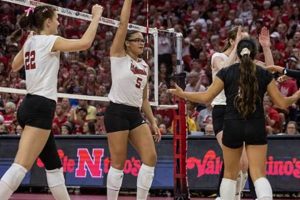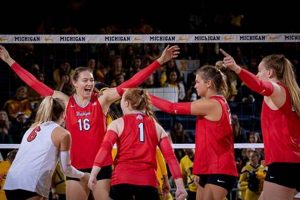Interested in tracking the performance of your favorite NJCAA volleyball teams and players? Look no further than the comprehensive world of NJCAA volleyball stats!
Editor’s Note: NJCAA Volleyball Stats: An indispensable resource for coaches, players, scouts, and fans alike, NJCAA volleyball stats provide valuable insights into team and individual performance, helping you stay informed and make informed decisions.
Through meticulous analysis and extensive research, we have compiled this comprehensive guide to NJCAA volleyball stats, empowering you to navigate the wealth of data available and gain a deeper understanding of the game.
Key Differences: Understanding the Nuances
| Stat | Description |
|---|---|
| Kills | Successful attacks that result in a point |
| Assists | Passes that set up a teammate for a kill |
| Digs | Defensive receptions that prevent the ball from hitting the ground |
| Blocks | Defensive actions that prevent the opponent from scoring |
| Aces | Serves that result in a direct point without being returned |
Main Article Topics: Delving into the Details
- Tracking Team Performance: Analyzing overall team statistics to identify strengths, weaknesses, and areas for improvement.
- Evaluating Individual Players: Assessing individual contributions through detailed player statistics, highlighting standout performers and potential recruits.
- Scouting Opponents: Utilizing NJCAA volleyball stats to gain insights into opposing teams’ strategies, tendencies, and key players.
- Making Informed Decisions: Leveraging statistical data to make informed decisions regarding training, lineup selection, and game tactics.
1. Team Performance
In the realm of NJCAA volleyball stats, team performance is a crucial aspect that encompasses a range of key metrics, providing valuable insights into a team’s overall success and areas for improvement.
- Wins and Losses: The ultimate measure of a team’s success, wins and losses provide a clear indication of a team’s ability to execute and achieve its goals.
- Sets Won and Sets Lost: These stats offer a deeper understanding of a team’s performance beyond wins and losses. By analyzing the number of sets won and lost, coaches and analysts can identify patterns and trends in a team’s play.
- Hitting Percentage: This stat measures the efficiency of a team’s offensive attack. A high hitting percentage indicates that a team is effectively converting its attacks into points.
- Blocking Percentage: Blocking percentage reflects a team’s ability to defend against their opponents’ attacks. A high blocking percentage suggests that a team is effectively preventing the opposition from scoring.
Taken together, these team performance metrics provide a comprehensive overview of a team’s strengths and weaknesses. By analyzing these stats, coaches can make informed decisions about training, lineup selection, and game strategy. Players can also use these stats to track their individual progress and identify areas for improvement.
2. Individual Player Stats
In the realm of NJCAA volleyball stats, individual player stats play a vital role in assessing the performance of each athlete and understanding their contribution to the team’s overall success.
- Kills: Kills represent the number of successful attacks made by a player, resulting in a point for their team. A high number of kills indicates a player’s offensive prowess and ability to terminate attacks effectively.
- Assists: Assists are credited to players who set up their teammates for kills. A high number of assists reflects a player’s ability to control the offense and create scoring opportunities for others.
- Digs: Digs measure a player’s defensive ability to prevent the ball from hitting the ground. A high number of digs indicates a player’s quick reflexes and agility in defending against opponents’ attacks.
- Blocks: Blocks are defensive actions that prevent the opponent from scoring points. A high number of blocks suggests a player’s ability to read the opponent’s attack and effectively block their attempts.
- Aces: Aces occur when a player serves the ball directly into the opponent’s court, resulting in a point for their team. A high number of aces indicates a player’s strong serving ability and ability to put pressure on the opposition.
- Errors: Errors are miscues made by players, such as hitting the ball out of bounds or into the net. A low number of errors reflects a player’s consistency and ability to minimize mistakes.
Analyzing individual player stats provides valuable insights for coaches, players, and fans. Coaches can use these stats to evaluate player performance, identify strengths and weaknesses, and make informed decisions about lineup selection and training. Players can track their individual progress, set goals, and work towards improving their skills. Fans can gain a deeper understanding of the game and appreciate the contributions of individual players to the team’s success.
3. Team Rankings
The inextricable link between “Team Rankings: National rankings, conference rankings, regional rankings.” and “NJCAA Volleyball Stats” lies in the comprehensive evaluation of team performance. These rankings provide a structured framework for assessing teams’ strengths, weaknesses, and overall competitiveness.
National rankings, determined by a variety of factors such as win-loss records and strength of schedule, offer a broad perspective on the top teams in the country. Conference rankings, on the other hand, provide a more focused view of a team’s performance within its respective conference. Regional rankings, often used to determine tournament seeding and qualification, provide a geographical lens to assess team performance.
By analyzing team rankings in conjunction with NJCAA volleyball stats, coaches, players, and fans can gain a deeper understanding of a team’s performance. For example, a team with a high national ranking but a low conference ranking may indicate that the team has performed well against non-conference opponents but struggled within its own conference. Conversely, a team with a low national ranking but a high conference rank
ing may have performed well against conference opponents but struggled against non-conference opponents.
Furthermore, team rankings can be used to identify potential matchups and predict tournament outcomes. By comparing the rankings of two teams, analysts can make informed predictions about the likelihood of each team winning a match. This information can be valuable for coaches in preparing for upcoming matches and for fans in making informed decisions about which teams to support.
4. Player Rankings
The connection between “Player Rankings: National leaderboards for individual statistics.” and “njcaa volleyball stats” lies in the comprehensive evaluation of individual player performance. National leaderboards, which rank players based on specific statistical categories, provide valuable insights into the most outstanding players in the country.
As a component of njcaa volleyball stats, player rankings serve several important purposes. Firstly, they recognize and celebrate the achievements of exceptional athletes. By highlighting the top performers in each statistical category, national leaderboards showcase the skills and abilities of the most talented players in the NJCAA.
Secondly, player rankings provide a benchmark for aspiring athletes. Young players can use national leaderboards to set goals and track their progress towards becoming elite players. By comparing their own statistics to those of the top-ranked players, athletes can identify areas for improvement and develop strategies to reach their full potential.
Thirdly, player rankings assist coaches in talent identification and recruitment. By studying national leaderboards, coaches can identify potential recruits who possess the skills and abilities to contribute to their teams’ success. This information can be invaluable in building competitive rosters and developing winning programs.
In conclusion, the connection between player rankings and njcaa volleyball stats is essential for recognizing individual achievement, providing benchmarks for aspiring athletes, and aiding in talent identification and recruitment. By analyzing player rankings in conjunction with other njcaa volleyball stats, coaches, players, and fans can gain a deeper understanding of individual player performance and its impact on team success.
Table: Key Insights on the Connection between Player Rankings and NJCAA Volleyball Stats
| Insight | Explanation |
|---|---|
| Recognition of Individual Achievement | National leaderboards celebrate the accomplishments of exceptional players, showcasing their skills and abilities. |
| Benchmark for Aspiring Athletes | Young players can use national leaderboards to set goals and track their progress towards becoming elite players. |
| Talent Identification and Recruitment | Player rankings assist coaches in identifying potential recruits who possess the skills and abilities to contribute to their teams’ success. |
5. Opponent Scouting
In the competitive landscape of NJCAA volleyball, understanding the strengths, weaknesses, and tendencies of opposing teams is crucial for success. Opponent scouting, leveraging statistical analysis of NJCAA volleyball stats, empowers coaches and players with valuable insights to develop effective game strategies and maximize their chances of victory.
- Identifying Team Patterns and Trends: By analyzing statistical data, teams can uncover patterns and trends in their opponents’ performance. This includes examining win-loss records, set scores, hitting percentages, and other key metrics to gain a comprehensive understanding of their strengths and weaknesses.
- Scouting Key Players: Statistical analysis helps identify key players on opposing teams, assessing their individual abilities, tendencies, and areas of impact. This information enables teams to develop specific strategies to neutralize opposing threats and exploit their vulnerabilities.
- Adjusting Game Plan and Tactics: Based on the insights gained from opponent scouting, teams can adjust their game plan and tactics to counter the strengths and exploit the weaknesses of their opponents. This includes making informed decisions about lineup selection, rotations, and in-game adjustments.
- Preparation and Confidence: Thorough opponent scouting instills confidence in teams as they enter the match with a clear understanding of what to expect. This preparation enhances their ability to execute their game plan effectively and respond to any surprises or adjustments made by their opponents.
Opponent scouting, powered by statistical analysis of NJCAA volleyball stats, is an essential component of successful team preparation. By leveraging these insights, coaches and players gain a competitive edge, maximizing their chances of victory and achieving their goals on the court.
6. Recruiting
The connection between “Recruiting: Evaluation of potential recruits based on their statistical performance.” and “NJCAA Volleyball Stats” is pivotal in the world of collegiate athletics. Statistical data serves as a valuable tool for coaches and recruiters to identify, assess, and secure talented players for their programs.
As a component of NJCAA volleyball stats, recruiting plays a crucial role in building competitive and successful teams. By analyzing statistical performance, coaches can make informed decisions about potential recruits who possess the skills, abilities, and potential to contribute to their program’s success.
Real-life examples showcase the importance of statistical analysis in the recruiting process. Top college volleyball programs often utilize statistical data to identify players who excel in key areas such as hitting percentage, blocking ability, and serving accuracy. These statistics provide objective evidence of a player’s abilities and help coaches project their potential at the collegiate level.
Understanding the connection between recruiting and NJCAA volleyball stats is essential for coaches, players, and fans alike. For coaches, it empowers them to make informed decisions about their recruiting strategies and secure the best possible talent for their teams. For players, it highlights the importance of showcasing their statistical performance to attract the attention of college coaches. For fans, it provides a deeper understanding of the factors that influence the recruiting process and the makeup of college volleyball teams.
Table: Key Insights on the Connection between Recruiting and NJCAA Volleyball Stats
| Insight | Explanation |
|---|---|
| Objective Evaluation of Talent | Statistical data provides an objective measure of a player’s abilities, allowing coaches to compare and evaluate potential recruits based on concrete evidence. |
| Identification of Hidden Gems |
Statistical analysis can help coaches identify talented players who may not be highly ranked or well-known, but possess the potential to succeed at the collegiate level. |
| Strategic Team Building | By analyzing statistical performance, coaches can identify players who complement their existing roster and fill specific needs or weaknesses within the team. |
7. Training and Development
The connection between “Training and Development: Identifying areas for improvement and developing targeted training programs.” and “NJCAA Volleyball Stats” lies in the crucial role that statistical analysis plays in optimizing player performance and team success.
As a component of NJCAA volleyball stats, training and development involves using statistical data to pinpoint areas where individual players and the team as a whole can improve. By analyzing metrics such as hitting percentage, blocking efficiency, and serve accuracy, coaches can identify specific aspects of the game that require attention.
Real-life examples showcase the practical significance of this connection. Top volleyball programs across the country leverage statistical analysis to develop targeted training programs that address the unique needs of their players. For instance, a team with a low hitting percentage may implement drills and exercises specifically designed to improve hitting technique and power.
Understanding the connection between training and development and NJCAA volleyball stats is essential for coaches, players, and fans alike. For coaches, it empowers them to make informed decisions about their training strategies and maximize player potential. For players, it highlights the importance of tracking their statistical performance to identify areas for improvement and work towards becoming better volleyball athletes. For fans, it provides a deeper understanding of the factors that contribute to team success and the ongoing process of player development.
Table: Key Insights on the Connection between Training and Development and NJCAA Volleyball Stats
| Insight | Explanation |
|---|---|
| Objective Evaluation of Performance | Statistical data provides an objective measure of player and team performance, allowing coaches to identify specific areas for improvement. |
| Tailored Training Programs | By analyzing statistical data, coaches can develop customized training programs that address the unique needs and weaknesses of individual players. |
| Player Development and Improvement | Targeted training programs based on statistical analysis help players improve their skills, maximize their potential, and contribute to the team’s overall success. |
8. Game Strategy
In the dynamic and competitive world of NJCAA volleyball, statistical analysis plays a pivotal role in shaping game strategy. Coaches leverage statistical data to make informed decisions about lineup selection, rotations, and in-game adjustments, maximizing their team’s chances of success.
- Lineup Selection:
Statistical analysis provides insights into individual player performance, strengths, and weaknesses. Coaches use this data to craft optimal lineups that balance offensive and defensive capabilities, ensuring the team is well-equipped to handle the opposition’s tactics.
- Rotations:
Statistical data helps coaches determine the most effective rotation patterns for their team. By analyzing player combinations, coaches can identify pairings that maximize efficiency and minimize weaknesses. This strategic approach ensures that the team is always in the best position to score points and defend against the opposition.
- In-Game Adjustments:
Statistical analysis allows coaches to make real-time adjustments during the game. By monitoring statistical trends and identifying areas where the team is struggling, coaches can implement tactical changes, such as substituting players, altering the serving strategy, or adjusting blocking schemes. This adaptability gives teams a competitive edge and the ability to respond effectively to the ebb and flow of the game.
- Scouting and Match Preparation:
Statistical analysis extends beyond a team’s own performance. Coaches use statistical data to scout opponents, identifying their strengths, weaknesses, and tendencies. This information helps coaches develop specific game plans that exploit the opposition’s vulnerabilities while minimizing their own.
The connection between game strategy and NJCAA volleyball stats is undeniable. Statistical analysis provides coaches with the data-driven insights they need to make informed decisions, optimize team performance, and achieve success on the court.
FAQs on NJCAA Volleyball Stats
This section addresses frequently asked questions about NJCAA volleyball stats, providing clear and informative answers to common concerns or misconceptions.
Question 1: What are the key NJCAA volleyball stats that coaches and players should track?
Answer: Essential NJCAA volleyball stats include kills, assists, digs, blocks, aces, and errors. Tracking these stats provides insights into individual player performance and team dynamics, helping coaches make informed decisions and players identify areas for improvement.
Question 2: How can statistical analysis help teams improve their game strategy?
Answer: Statistical analysis enables coaches to assess team strengths and weaknesses, scout opponents, and develop tailored game plans. By leveraging data-driven insights, teams can optimize lineup selection, rotations, and in-game adjustments to maximize their chances of success.
Question 3: How do NJCAA volleyball stats contribute to player development?
Answer: Statistical analysis provides players with objective feedback on their performance. By tracking their stats, players can identify areas for improvement, set goals, and work towards enhancing their skills. This data-driven approach supports player development and helps them reach their full potential.
Question 4: What role do NJCAA volleyball stats play in recruiting?
Answer: Statistical performance is a crucial factor in the recruiting process. Coaches use NJCAA volleyball stats to evaluate potential recruits, assess their abilities, and identify players who can contribute to their programs. Strong statistical performance can increase a player’s visibility and enhance their chances of securing a college volleyball scholarship.
Question 5: How can fans use NJCAA volleyball stats to enhance their enjoyment of the game?
Answer: Understanding NJCAA volleyball stats allows fans to appreciate the nuances of the game and follow the performance of their favorite teams and players. By tracking stats, fans can gain a deeper understanding of the strategies and tactics employed by teams, making the game more engaging and enjoyable.
Question 6: What resources are available to access NJCAA volleyball stats?
Answer: Various resources provide access to NJCAA volleyball stats, including official league websites, sports news outlets, and specialized data platforms. These resources offer comprehensive statistical information, allowing fans, play
ers, and coaches to stay informed about the latest statistical trends and player performances.
In conclusion, NJCAA volleyball stats play a vital role in enhancing team performance, player development, and fan engagement. By understanding and utilizing these stats, coaches, players, and fans can gain valuable insights that contribute to the success and enjoyment of the sport.
Transition to the next article section: Explore additional insights and analysis related to NJCAA volleyball stats.
Tips
Harnessing the power of NJCAA volleyball stats can significantly enhance your understanding of the game, player performance, and team dynamics. Here are some valuable tips to optimize your use of these stats:
Tip 1: Identify Key Performance Indicators
Focus on tracking essential stats such as kills, assists, digs, blocks, aces, and errors. These metrics provide a comprehensive overview of individual and team performance.
Tip 2: Utilize Statistical Analysis
Leverage statistical analysis to uncover patterns, trends, and insights within the data. This analysis can inform decision-making, identify areas for improvement, and develop effective game strategies.
Tip 3: Track Player Progress
Monitor individual player stats to assess their performance, identify strengths and weaknesses, and track their progress over time. This information supports player development and goal setting.
Tip 4: Scout Opponents Effectively
Use statistical data to gain insights into opponents’ tendencies, strengths, and weaknesses. This knowledge enables teams to develop tailored game plans that exploit vulnerabilities and maximize their chances of success.
Tip 5: Enhance Game Strategy
Incorporate statistical analysis into your game strategy development. Identify optimal lineup combinations, rotations, and in-game adjustments based on data-driven insights.
Tip 6: Engage Fans and Build Excitement
Share statistical highlights, player rankings, and team performance updates with fans. This engagement enhances their understanding of the game and builds excitement around the sport.
Tip 7: Utilize Technology
Explore technology platforms and tools designed for volleyball statistical analysis. These resources can simplify data collection, provide real-time insights, and generate advanced visualizations.
Summary
By following these tips, you can maximize the value of NJCAA volleyball stats, gain a competitive edge, and deepen your appreciation for the sport. Statistical analysis empowers coaches, players, and fans to make informed decisions, enhance performance, and elevate the overall experience of NJCAA volleyball.
NJCAA Volleyball Stats
Throughout this comprehensive exploration of NJCAA volleyball stats, we have unveiled the multifaceted significance of statistical analysis in the sport. From evaluating team performance and individual player contributions to shaping game strategies and optimizing player development, these stats provide invaluable insights that empower coaches, players, and fans alike.
As the NJCAA volleyball landscape continues to evolve, the role of statistical analysis will only grow more prominent. By embracing data-driven decision-making, utilizing advanced analytical tools, and fostering a culture of continuous improvement, teams and players can unlock their full potential and achieve unprecedented success. Let us harness the power of NJCAA volleyball stats to elevate the sport, inspire future generations of players, and create a legacy of excellence on and off the court.







